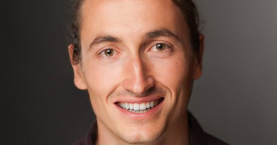
Cédric Cannard is a French researcher working on altered states of consciousness and psi phenomena.
Career
Cédric Cannard completed a MSc in neuropsychology and clinical neuroscience in France, with research focused on brain atrophies in schizophrenia (MRI) and brain oscillations involved in visual perception (EEG). In 2022, Cannard completed a PhD in neuroscience under the mentorship of Arnaud Delorme, working on well-being, EEG methods, and wearable neurotechnology. Cannard worked as a senior research associate at the Institute of Noetic Sciences, at the intersection between signal processing (EEG, ECG, PPG, EDA, EGG), altered states of consciousness, and psi phenomena (with a focus on presentiment/precognition). He is now Director of Neuroscience at Evolve.
Predictive Brain Processes
In a study currently under review, Cannard and co-workers explored presentiment in brain activity. They measured activity known as contingent negative variation (CNV), which shows up in the front part of the brain when we're expecting something. However, Cannard was looking to see what happens when events are unpredictable. Eighty-one female participants were exposed to different types of pictures (pleasant, neutral and unpleasant) in random order. Cannard found very significant brain activity changes around 110 milliseconds preceding pleasant pictures only (p < 0.001).1
Telephone Telepathy
Cannard and the IONS team explored the ability of participants to identify callers using telepathy or precognition, by completing trials where callers were chosen before or after guesses, respectively. Among 177 participants, those in telepathic trials exceeded chance (50.0% vs. 33.3% p < 0.001), whereas precognitive trials did not (31.9% vs. 33.3%). Genetic relatedness notably impacted accuracy (for instance, 25% genetic relatedness had 2.88 times higher odds of identifying the caller, p = 0.04). Communication frequency correlated positively (p = 0.03), while emotional closeness and physical distance did not significantly affect outcomes. Although the telepathy results favoured the psi hypothesis, the failure to find psi in more stringent precognition testing leaves open more conventional explanations like cheating and sensory leakage.2
Optics Experiments
In a 2021 publication, Cannard with Loren Carpenter and Dean Radin describe experiments investigating the effects of intention on an optical physics system: photon polarization. A laser beam was passed through horizontal and vertical polarizers while participants were asked to focus their intention for the beam’s polarization to rotate so that photons would reach the detector. Against prediction, two exploratory experiments showed decreasing illumination with intention (p = 0.05). This motivated a third experiment where subjects were asked to decrease the intensity of light being directed through a reflective sphere. Analysis of the data revealed an increase in photon counts with intention - again, contrary to prediction. These data underscore the difficulty in isolating the location of a PK effect, be it in the photon behaviour, the detectors or other experimental aspects. These unexpected outcomes strongly go against a 'psi - experimenter effect' explanation for the significant findings.3
Upsight
In a paper under review, Cannard and IONS colleagues investigated differences in brain electrical activity between two laboratory conditions in an individual who reports a subjective experience of a phenomenon he calls ‘upsight’. The individual describes this as the capacity to perceive at will holographic images as though they appear on an inset screen that overlays his ordinary visual field, with eyes open or closed. EEG data were collected as the participant shifted between the upsight state and a control condition of recollecting previously viewed images. Statistically significant decline in whole-scalp brain activity in the alpha and beta frequency bands were observed during the upsight condition compared to the control condition (visual mental imagery).4
Death Classification
Cannard contributed to a 2020 study in which participants were asked to look at 180 facial photographs of deceased individuals and guess the cause of death from among three possible options: heart attack, death by gunshot or car accident. Both electroencephalogram (EEG) and electrocardiogram (ECG) data were collected. Overall evidence indicated accurate guesses by participants (p = 0.004), but, unexpectedly, this was primarily driven by the performance of control subjects not claiming any mediumistic ability (p = 0.005). This was possibly linked to the larger ERP (event related potential) amplitudes following image presentation that was shown by control participants, indicating greater attention and less response inhibition.5
Michael Duggan
Literature
Cannard, C. et al. (under review). Brain Predictive Processes.
Cannard, C., Vieten, C., Yount. G., & Delorme, A. (under review). A case study of differences in brain electrical activity between recall-based mental imagery and a subjective phenomenon of “upsight”. Journal of Anomalous Experience and Cognition.
Carpenter, L., Cannard, C., Wahbeh, H., & Radin, D. (2021). Psychophysical interactions with photons: Three exploratory studies with unexpected results. Journal of the Society for Psychical Research 85/1, 31-48.
Delorme, A., Cannard, C., Radin, D., Wahbeh, H. (2020). Accuracy and neural correlates of blinded mediumship compared to controls on an image classification task. Brain and Cognition 146, Article 105638.
Wahbeh, H., Cannard, C., Okonsky, J., & Delorme, A. (2019). A physiological examination of perceived incorporation during trance. F1000Research. 8, 67.
Wahbeh, H., Cannard, C., Radin, D., & Delorme, A. (2024). Who's calling? Evaluating the accuracy of guessing who is on the phone. Explore: The Journal of Science and Healing 20/2, 239-47.
Wahbeh, H., Radin, D., Cannard, C., & Delorme, A. (2022). What if consciousness is not an emergent property of the brain? Observational and empirical challenges to materialistic models. Frontiers in Psychology 13, 5596.

